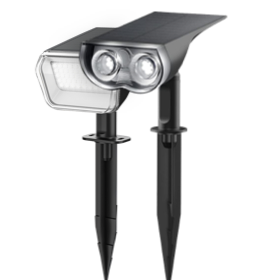Do Solar Lights Need Direct Sunlight? Charging Secrets, Maintenance Hacks & Smart Solutions
-
“Do Solar Lights Need Direct Sunlight?”
-
No—but they require at least 4–6 hours of direct or indirect sunlight daily for optimal charging.
But their charging efficiency depends on sunlight quality, battery capacity and seasonal shifts. Solar lights thrive as “set-and-forget” solutions, but their autonomy is a trade-off. Unlike wired lights that deliver steady brightness, solar models dim as batteries drain—signaling it’s time to clean panels or relocate them.
In This Article:
- How Solar Lights Work
- Do Solar Lights Need Direct Sunlight?
- How Much Sunlight Do Solar Lights Need?
- Solar Lights on Cloudy Days: What to Expect
- 5 Pro Tips to Extend Solar Light Lifespan
- Linkind Solar Light Solutions: Elevate Your Outdoor Spaces
- FAQs
No more guessing—transform flickering glows into reliable, all-night radiance.

How Solar Lights Work
Solar lights operate as self-contained energy ecosystems, seamlessly converting sunlight into nighttime glow through a blend of physics, engineering, and smart automation. Whether you’re powering bright solar landscape lights to illuminate pathways or solar lantern lights for ambient garden decor, their core components—panels, batteries, and LEDs—determine reliability. Let’s break down the process into three fundamental stages and explore why even small tweaks to each phase can dramatically boost performance.
The 3-Step Solar Lighting Cycle
Solar lights rely on a clean, closed-loop system to harvest and deploy energy. Here’s how they transform daylight into after-dark radiance:
1. Sunlight Absorption: Photovoltaic (PV) panels, typically made of monocrystalline or polycrystalline silicon, absorb photons from sunlight. This triggers the photovoltaic effect, generating direct current (DC) electricity. Modern panels achieve 18–22% efficiency, meaning they convert nearly one-fifth of captured sunlight into usable energy.
2. Battery Storage: The generated DC energy flows into rechargeable batteries—commonly lithium-ion or nickel-metal hydride (NiMH). A 2000mAh battery, for example, can store enough power to illuminate a 10-lumen LED for 8–12 hours. However, battery health degrades over time; after 2–3 years, capacity may drop by 30%, reducing runtime.
3. Automated Illumination: A built-in light sensor triggers LEDs at dusk. Energy-efficient LEDs (consuming 0.5–2 watts) draw power from the battery until dawn or until charge depletes. Advanced models include dimming modes or motion sensors to extend operation during low-sun periods.
Key Factors Affecting Performance:
While the process appears straightforward, real-world efficiency hinges on variables that separate mediocre solar lights from all-night champions. Here are the primary make-or-break elements:
Sunlight Intensity: Direct, midday sun delivers 1000W/m² of energy—charging panels 3x faster than the 300W/m² typical on cloudy days. Even partial shade (e.g., from tree branches) can reduce output by 50%.
Panel Efficiency: Monocrystalline panels, with their uniform silicon structure, outperform polycrystalline models in low-light conditions, achieving 18–22% efficiency versus 15–17%. Dust or pollen layers on panels can block 20–30% of incoming photons.
Battery Health: Lithium-ion batteries retain 80% capacity after 500 cycles but degrade 2x faster in hot climates (95°F/35°C) versus moderate temperatures (70°F/21°C). NiMH batteries, while cheaper, lose 15–20% charge monthly due to self-discharge.
Do Solar Lights Need Direct Sunlight?
The idea that solar lights “need” direct sunlight is both true and misleading. While peak performance relies on unfiltered sun exposure, advancements in photovoltaic technology and battery storage have made modern solar lights far more adaptable than their predecessors. Misconceptions persist, however, often leaving users frustrated with dim or inconsistent performance—even when solutions exist. Below, we dismantle three pervasive myths to clarify what solar lights truly require and how to work with their limitations, not against them.
Myth 1: “Solar Lights Only Work in Direct Sunlight”
Reality: Garden lighting thrives even in partial shade. Modern monocrystalline panels can harness diffused light on cloudy days, albeit at reduced efficiency (30–50% slower charging). For example, a fixture needing 6 hours of direct sun might require 10–12 hours under overcast skies. Reflective surfaces like white walls or pavers can bounce additional photons onto panels, compensating for partial shade.
Myth 2: “Solar Lights Are Useless in Winter”
Reality: Winter challenges solar lights but doesn’t cripple them. Shorter days and angled sunlight reduce output by 30–50%, but strategic placement can offset this. Tilt panels toward the winter sun’s lower arc (45° angle) and clear snow promptly. Some models, like those with detachable panels, let you position collectors in sunny spots while keeping lights in shaded areas.
Myth 3: “Shaded Areas Completely Disable Solar Lights”
Reality: Partial shade (e.g., dappled light under trees) still delivers usable energy—just inconsistently. A panel receiving 3 hours of dappled sunlight and 3 hours of indirect light might achieve a 60% charge, enough for 4–5 hours of runtime. However, full shade (e.g., under dense evergreens) starves panels entirely. Solution? Opt for “split systems” with panels mounted remotely in sunny locations, connected to lights in dark zones.
How Much Sunlight Do Solar Lights Need?
Solar lights aren’t one-size-fits-all when it comes to sunlight requirements—their needs vary based on panel efficiency, battery capacity, and environmental conditions. While “more sun is better” holds true, modern engineering allows these devices to adapt to less-than-perfect scenarios. Understanding the sweet spot between minimum and optimal exposure ensures your lights shine reliably, whether you’re dealing with a shaded patio or cloudy coastal weather. Below, we break down daily sunlight benchmarks, low-light workarounds, and the tech that bridges the gap.
Daily Sunlight Guidelines:
Optimal Conditions: 6–8 hours of direct sunlight daily powers most solar lights to full capacity, delivering 8–12 hours of nighttime illumination. This is ideal for high-output fixtures like motion-sensor floodlights.
Minimum Threshold: 4 hours of bright indirect light (e.g., reflected off light-colored surfaces or filtered through sheer shades) can sustain basic pathway lighting. Expect 5–6 hours of runtime, though dimming may occur toward dawn.
Cloudy/Daylight Challenges: Overcast skies cut charging efficiency by 30–50%. High-efficiency panels (≥20% conversion rate) outperform standard models here, squeezing 20% more energy from diffuse light.
Pro Tip: Solar lights with MPPT (Maximum Power Point Tracking) technology dynamically adjust voltage to extract every available photon in low-light conditions. For example, an MPPT-equipped light can harvest 15–25% more energy than non-MPPT models under partial shade or winter sun.
Solar Lights on Cloudy Days: What to Expect
While solar lights don’t hibernate when clouds roll in, their charging capabilities shift into low gear—a reality that frustrates many users. The key lies in managing expectations: cloudy-day performance depends on cloud density, seasonal light angles, and battery chemistry. Below, we decide how different weather scenarios impact charging and share tactical upgrades to turn “barely functional” into “surprisingly reliable.”
Cloud Cover’s Hidden Hierarchy
Not all cloudy days are created equal. Solar panels react sharply to variations in light diffusion:
Bright Overcast (Thin Clouds): Allows 50–70% of normal charging speed. A panel needing 6 hours of direct sun might take 8–9 hours here.
Heavy Clouds/Rain: Blocks up to 80% of photons, slashing output to 20–30%. Lithium-ion batteries (with 95% charge retention at 32°F/0°C) outperform NiMH in these damp, chilly conditions.
Winter’s Double Whammy: Short days + thick clouds compound charging deficits. Pair panels with a 45° winter tilt to capture oblique sunlight, and prioritize lights offering “low-light mode” for extended runtime.
3 Hacks to Outsmart Gloomy Skies
Don’t resign to dim lights—engineer resilience. These proven strategies exploit every available photon:
1. Angle Panels Toward the Brightest Sky Zone
Panels lying flat miss scattered light. Tilting them 30–45° toward the sky’s brightest quadrant (often south in the Northern Hemisphere) increases photon capture by 15–20%, even under uniform clouds.
2. Clean Panels Weekly—Yes, Weekly
Dust cripples solar lantern lights faster due to their decorative, often textured surfaces.
3. Deploy DIY Reflectors
Boost ambient light with budget-friendly reflectors:
-
Mirrors: Position at a 60° angle to bounce light onto panels.
-
Aluminum Foil: Wrap cardboard sheets in foil and place around the panel’s base.
-
White Pavers: Install light-colored stones beneath ground-mounted lights to reflect ground-level photons.
5 Pro Tips to Extend Solar Light Lifespan
Solar lights promise low maintenance—but "low" doesn’t mean "zero." Batteries degrade, sensors glitch, and weather takes its toll. The difference between fixtures that fizzle in a year and those lasting 5+ seasons? Proactive care tailored to their solar-powered DNA. These aren’t generic tips; they’re battle-tested strategies addressing the unique vulnerabilities of photovoltaic systems. Master them, and you’ll slash replacement costs while maximizing brightness.
Winter Care: Lithium-ion batteries lose 20–30% capacity when exposed to temperatures below -20°F (-29°C) for extended periods. Store lights indoors during deep freezes, but first discharge batteries to 50% to prevent stress. Reactivate them in spring with a 12-hour sun soak to recalibrate sensors.
Reset Sensors Monthly: Vital for bright solar landscape lights with motion sensors, ensuring consistent activation. Cover panels for 72 hours to drain batteries fully, then expose to direct sun. This resets the charge controller and clears “memory effect” in older NiMH batteries.
Avoid Artificial Light: Streetlights or porch bulbs near solar panels confuse dawn/dusk sensors, keeping LEDs off when they should charge. Relocate fixtures at least 10 feet (3 meters) from competing light sources, or install shields (e.g., black PVC tubing) around panels to block ambient glare.
Upgrade Batteries: Standard lithium-ion batteries last 2–3 years; lithium iron phosphate (LiFePO4) counterparts endure 5–7 years with 2000+ cycles. Their stable chemistry resists heat degradation (key for rooftop-mounted lights) and performs better in sub-freezing temps.
Trim Nearby Foliage: Overgrown plants don’t just cast shade—they trap humidity, accelerating corrosion on battery terminals. Trim branches to maintain 2 feet (60 cm) of clearance around fixtures, and spray electrical contacts with anti-corrosion silicone annually.
Linkind Solar Light Solutions: Elevate Your Outdoor Spaces
Imagine nights where your garden glows like a curated art gallery—pathways bathed in warm radiance, trees silhouetted by dynamic spotlights, and motion-triggered beams that outsmart the darkest corners. Linkind solar arsenal turns this vision into reality with four purpose-built heroes: the SL5C and SL5 spotlights for drama and security, paired with the SP3 and SP5 pathway lights for elegance and guidance. Blending military-grade durability, app-powered intelligence, and design flair, this lineup doesn’t just light your yard—it redefines what solar can do. Ready to eclipse ordinary outdoor lighting? Let’s spotlight the game-changers.
Linkind Smart Solar Spotlight SL5C – The All-Night Sentinel
Forget "good enough." The SL5C’s MPPT tech hijacks every photon, charging fully in 4 hours of partial shade to unleash 14-hour runtime—even in winter’s gloom. Sync its 16 million colors to music via app, tilt its 360° head to highlight sculptures, or let its IP67 armor shrug off monsoons. This isn’t a spotlight; it’s a solar-powered Swiss Army knife.

-
Enhanced Solar Efficiency: Experience 24/7 illumination with these smart solar spotlights featuring MPPT technology that improves charging by 23.5%. Premium 5C automotive-grade technology delivers up to 14 hours of continuous solar powered spotlight performance.
-
App & Voice Control: Manage your solar landscape spotlights through the AiDot app or use voice commands with Amazon Alexa and Google Home via Linkind's Bluetooth Mesh Hub for convenient control of your solar outdoor spotlight network.
-
Dynamic Color Effects:Transform your yard with color changing solar spotlights offering 16 million color options. Create stunning light shows that sync with music—perfect for enhancing your landscape with solar spotlights for yard decoration.
-
Intelligent Scheduling: Program your solar colored spotlights with smart timers including dusk-to-dawn automation and customized schedules. Set your preferred brightness levels and timing to maximize your solar landscape spotlights' effectiveness.
-
Versatile Installation: Mount these IP67 waterproof solar outdoor spotlights on walls or ground with 360° horizontal and 180° vertical adjustability. Group up to 32 lights into 8 separate zones for comprehensive yard illumination.
Linkind Smart Solar Spotlight SL5 – The Symphony Conductor
Command a lighting orchestra. Group up to 32 SL5s wirelessly across 8 zones, then choreograph them into Motion Mode security alerts, Luminance Mode dusk-to-dawn elegance, or a music-synced RGBTW rave. Mount it on walls or soil, pivot its head 180°, and watch it turn shrubs into focal points.

-
Group Control: The world's first solar spotlight with wireless capabilities to offer smart group control functionality.
-
Multiple Convenient App Functions: Control smart spotlights with the AiDot App. Adjust color, temperature, brightness, and use group control, music sync, and energy-saving features.
-
Music Sync & Preset Scenes: Sync RGBTW smart solar lights with music by granting microphone permission. Customize effects, preset scenes, or choose from 16 million colors to enhance your outdoor ambiance.
-
Three Optional Lighting Modes: Linkind solar lights feature 3 modes: Motion for safety and efficiency, Luminance for automatic dusk-to-dawn lighting, and Continuous for constant illumination.
-
Enhanced Lighting & Easy Installation: Linkind solar spotlights are adaptable for ground or wall mounting, with 360° horizontal and 180° vertical adjustability.
Linkind Solar Pathway Light SP3 – Cosmic Elegance, Grounded
Why settle for mundane? The SP3’s planet-inspired design casts celestial shadows, while its 200-lumen glow blankets 2-meter circles—perfect for framing garden beds or deck stairs. Auto sensors handle on/off duties, and 4 height settings adapt to your landscape’s personality. Rain? Dust? Its IP54 shield just smirks.

-
Auto On/Off Sensor: Linkind SP3 Solar Lights feature automatic dusk-to-dawn activation, powered by light-sensitive sensors for hassle-free operation.
-
Unique Decorative Design: Embracing a planet-inspired aesthetic, these solar lights cast mesmerizing shadows akin to Venus's circular reflection, adding elegance to your outdoor setting.
-
Super Bright Illumination: Emitting up to 200lm brightness and covering a wide 2m diameter, these LED solar path lights brilliantly enhance your garden, landscape, or patio.
-
Easy Installation Options: With four height options for effortless setup, these landscape lights offer customizable illumination to illuminate your outdoor spaces with ease.
-
Highly Waterproof Construction: Crafted from premium ABS material with IP54 waterproofing, these solar lights endure harsh weather conditions for durable, long-lasting performance.
Linkind Smart Solar Pathway Light SP5 – The Mood Alchemist
Turn pathways into mood boards. The SP5’s 300-lumen wide beams erase shadows, while 16 million RGB hues let you pivot from midnight garden parties to serene moonlit strolls. Detect movement 26 feet away for instant security bursts or let Sunlight Mode auto-dim to conserve energy. Stake it in seconds; let IP65 toughness handle the rest.

-
Wide angle & super bright: Illuminating your world with wide-angle, super bright light of 300 lumens that will leave you in awe.
-
Multiple control modes: effortlessly manage your devices through the Aidot app or Voice control (hub required) and revel in the convenience.
-
Multicolor:Customizable color temperature and 16 million RGB options to set the perfect mood.
-
Multiple modes:Experience the best of both worlds with Sunlight and Motion modes with perfect for any mood!
-
Durable & Weatherproof: The IP65 rating showcases the product's impressive resilience against tough weather.
-
Motion activated: the light automatically turns on once motion is detected within 26 feet
-
Easy Installation: The ground insert feature adds convenience to the product's usability.
Designer Tip: Layer SL5C spotlights (angled at trees) with SP5 pathways (along walkways) for depth and drama. Add SP3s as garden accents and SL5s for perimeter security—voilà, a luminous ecosystem that’s equal parts beauty and brawn.
Conclusion
Solar lighting isn’t about chasing perfect sunlight—it’s about smart adaptation. With Linkind solar arsenal, you wield tools that thrive in shade, winter, or storms. Clean panels seasonally, tilt for angled sun, and let technology do the rest: MPPT charging hijacks weak light, IP65+ armor laughs at weather, and 16 million hues transform function into art. Whether illuminating hidden garden corners or securing driveways, these lights don’t just work—they perform. Ready to eclipse compromises? Pair SL5C’s brute efficiency with SP5’s RGB grandeur, sprinkle SP3’s cosmic charm, and let SL5 conduct the symphony. Darkness doesn’t stand a chance.
FAQs
Q1: Can solar lights charge through a window?
A: Yes, but efficiency drops by 40–50% due to glass reflection/UV filtering.
Q2: Is vinegar safe for cleaning solar panels?
A: Yes! Mix 1:1 white vinegar and water to dissolve hard water stains.
Q3: Can I use regular AA batteries in solar lights?
A: Avoid alkaline batteries—they leak. Use NiMH or lithium-ion rechargeables.






































